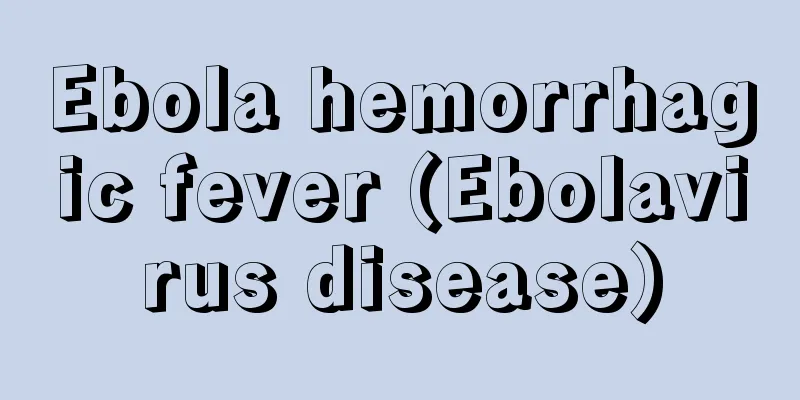Ebola hemorrhagic fever (Ebolavirus disease)

What kind of infection is it?At the end of June 1976, a male warehouseman working at a cotton factory in Nuzara, southern Sudan, showed symptoms similar to those of hemorrhagic fever, and then two other men in other departments fell ill with similar symptoms. This was the beginning of the first epidemic that was recognized as Ebola hemorrhagic fever. Starting from these three patients, the Ebola epidemic spread through infection within families and hospitals, and a total of 284 people developed Ebola hemorrhagic fever, of which 151 (53%) died. Separate from that epidemic, at the end of August of the same year, a man (a church school assistant) showed symptoms of hemorrhagic fever in Yambuku, in the northern part of the Democratic Republic of the Congo (formerly Zaire). A large-scale epidemic broke out through the treatment and nursing care at the Yambuku Church Hospital where the patient was admitted. A total of 318 similar cases occurred, and 280 (88%) died, and this was also confirmed to be hemorrhagic fever caused by the Ebola virus. These were the first confirmed epidemics. After that, sporadic Ebola outbreaks were confirmed in Sudan, the Democratic Republic of the Congo, and the Ivory Coast, but in 1995, a large-scale Ebola outbreak occurred centered on the general hospital in Kikwit, Bandundun Province, central Democratic Republic of the Congo. A total of 315 people became ill and 244 (77%) died during that outbreak. Even now, relatively large outbreaks continue in the Democratic Republic of the Congo, Gabon, and Sudan. Incidentally, the name Ebola comes from the name of a tributary of the Zaire River (the Ebola River) that flows through the village where the first patient in Yambuku was born. There have been several confirmed cases of Ebola virus infection from infected chimpanzees to humans, but apart from these cases, the source of infection for humans is unknown. Chimpanzees develop fatal hemorrhagic fever, just like humans. Research into Ebola hemorrhagic fever epidemics in Africa has shown that the spread of infection from person to person is due to the reuse of syringes and needles in poor medical and sanitation environments and close contact within households. In 2014, an unprecedented Ebola outbreak occurred in three countries: Guinea, Liberia, and Sierra Leone. According to an announcement by the World Health Organization (WHO) on November 21, 2014, the number of patients reached 15,319, with 5,444 deaths. This is the first Ebola outbreak of this scale, and the social infrastructure of these countries is being destroyed. On August 8, 2014, WHO declared it a "Public Health Emergency of International Concern." The outbreak is still ongoing, and continued support from the international community is required to prevent the spread of Ebola and restore social infrastructure. Recently, it has been suggested that the host of the Ebola virus is fruit bats in Africa. Although the disease has previously been called Ebola hemorrhagic fever, approximately 20% of Ebola hemorrhagic fever patients exhibit hemorrhagic symptoms, and therefore the disease is now known as "Ebola virus disease." How symptoms manifest The incubation period is 2 to 21 days. The Ebola virus is highly contagious through blood, and it is believed that there is a nearly 100% chance of infection through needlestick injuries. Symptoms include fever, Testing and diagnosisThe virus is easily isolated from the blood of patients in the early stages of the disease. It is difficult to diagnose viral hemorrhagic fever based on clinical symptoms alone, so the diagnosis is based on virological tests that detect viral antigens and specific antibodies against the virus. Treatment methodsThere is no specific treatment for Ebola hemorrhagic fever, and the basic treatment is symptomatic treatment such as rest, treatment for shock, and fluid and circulatory management. In Japan, Ebola hemorrhagic fever is classified as a Class 1 infectious disease under the Infectious Diseases Control Act, and patients are isolated and treated in rooms designed specifically for the treatment of such patients. Masayuki Saijo Source: Houken “Sixth Edition Family Medicine Encyclopedia” Information about the Sixth Edition Family Medicine Encyclopedia |
どんな感染症か1976年6月末、スーダン南部ヌザラの綿工場に勤める倉庫番の男性が出血熱様症状を示し、次いでほかの部署の男性2人も同様の症状で倒れました。これが初めてエボラ出血熱と認識された流行の幕開けでした。この3人の患者を源として家族内、病院内感染を通してエボラ出血熱の流行が拡大し、計284人がエボラ出血熱を発症して151人(53%)が死亡しました。 その流行とは別に、同年8月末にコンゴ民主共和国(旧ザイール)北部のヤンブクで1人の男性(教会学校の助手)が出血熱の症状を示しました。その患者が収容されたヤンブク教会病院での治療・看護を通じて大規模な流行が発生しました。計318人の同様の患者が発生し、280人(88%)が死亡しましたが、これもエボラウイルスによる出血熱であることが確認されました。これらが初めて確認された流行です。 その後、スーダン、コンゴ民主共和国、象牙海岸で散発的なエボラ出血熱の流行が確認されていましたが、1995年にコンゴ民主共和国中央部バンドゥンドゥン州キクウィトの総合病院を中心として、エボラ出血熱の大規模な流行が発生しました。その流行では計315人が発症して244人(77%)が死亡しました。今でも、コンゴ民主共和国、ガボン、スーダンで比較的大きな流行が続いています。ちなみにエボラの名は、ヤンブクの最初の患者の出身村を流れるザイール川支流の名(エボラ川)に由来しています。 感染したチンパンジーからヒトにエボラウイルスが感染した例がいくつか確認されていますが、それらのケースを除いてヒトへの感染源は不明です。チンパンジーもヒトと同様に致死的な出血熱を発症します。アフリカでのエボラ出血熱の流行を調査すると、ヒトからヒトへの感染の拡大は、貧しい医療衛生環境での注射器・注射針の使い回しや家族内での濃厚な接触が原因です。 2014年にはギニア、リベリア、シエラレオネの3カ国を中心に、これまでにない大きな規模のエボラ出血熱の流行が発生し、世界保健機関(WHO)の2014年11月21日の発表によると、患者数は1万5319人にのぼり、5444人が死亡しています。このような規模のエボラ出血熱の流行はかつてなく、これらの国々の社会基盤が破壊されつつあります。WHOは2014年8月8日に「国際的に懸念される公衆衛生上の緊急事態」であると宣言しました。現在でもその流行は続いており、エボラ出血熱の流行の阻止と社会基盤の回復に向けた国際社会の継続した支援が求められています。 最近、エボラウイルスの宿主はアフリカに生息するオオコウモリであると考えられています。 なお、これまでエボラ出血熱という病名が用いられてきましたが、エボラ出血熱患者の約2割において出血症状が認められ、全ての患者で出血症状が認められるわけではないことから、エボラ出血熱という病名から「エボラウイルス病」と呼ばれるようになっています。 症状の現れ方 潜伏期間は2~21日です。血液を介するエボラウイルスの感染力は強く、針刺し事故ではほぼ100%の確率で感染すると考えられています。症状は、発熱、 検査と診断発症初期の患者さんの血液から容易にウイルスが分離されます。臨床症状だけからウイルス性出血熱を診断することは難しく、ウイルス抗原およびウイルスに対する特異的抗体検出によるウイルス学的検査に基づいて診断を下すのが基本です。 治療の方法エボラ出血熱には特異的な治療法はなく、安静、ショックに対する治療、輸液・循環の管理などの対症療法が基本です。日本では、エボラ出血熱は感染症法で1類感染症に分類され、これらの患者さんの治療専用に設計されている病室に隔離し治療が行われます。 西條 政幸 出典 法研「六訂版 家庭医学大全科」六訂版 家庭医学大全科について 情報 |
<<: Ebola Liberalitas Julia - Ebola Liberalitas Julia
Recommend
Kumaishi [town] - Kumaishi
A former town in Nishi-gun, Hokkaido. Facing the S...
Rajahmundri (English spelling)
…a river in the central part of the Indian penins...
Straw mushroom - Straw mushroom
A mushroom of the Basidiomycete Amanita family. It...
Graz - Graz (English spelling)
It is the capital of the state of Styria in south...
Saltwater fish - Kaisuigyo (English spelling) sea fish
A fish that spends most or all of its life in the...
Glass thermometer
...A thermometer in which a liquid (a temperature...
Ratramnus
...However, this issue was not addressed directly...
Oriental Freedom Newspaper - Toyo Jiyu Newspaper
A daily newspaper founded in Tokyo on March 18, 1...
Government agency - Kancho
〘 noun 〙① An office of the Daijokan under the Rits...
Anorthite - anorthite
Anorthite is one of the six types of plagioclase,...
Okurashiki - Okurashiki
...According to family tradition, the Tachiiri cl...
Dorcus titanus
…Some males can reach a body length of over 7cm. ...
Kerry Blue Terrier
It is a domestic dog that originated in the UK. It...
Catalan Renaissance - Catalan Renaissance
... 19th century Catalonia was also full of energ...
Kifugetto - Kifugetto
...The flowers are white and fleshy, with lip-lik...









